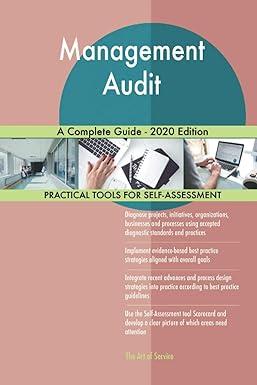Question
J.D. Williams, Inc., is an investment advisory firm that manages more than $120 million in funds for its numerous clients. The company uses an asset
J.D. Williams, Inc., is an investment advisory firm that manages more than $120 million in funds for its numerous clients. The company uses an asset allocation model that recommends the portion of each clients portfolio to be invested in a growth stock fund, an income fund, and a money market fund. To maintain diversity in each clients portfolio, the firm places limits on the percentage of each portfolio that may be invested in each of the three funds. General guidelines indicate that the amount invested in the growth fund must be between 20% and 40% of the total portfolio value. Similar percentages for the other two funds stipulate that between 20% and 50% of the total portfolio value must be in the income fund and at least 30% of the total portfolio value must be in the money market fund. In addition, the company attempts to assess the risk tolerance of each client and adjust the portfolio to meet the needs of the individual investor. For example, Williams just contracted with a new client who has $800000 to invest. Based on an evaluation of the clients risk tolerance, Williams assigned a maximum risk index of 0.05 for the client. The firms risk indicators show the risk of the growth fund at 0.10, the income fund at 0.07, and the money market fund at 0.01. an overall portfolio risk index is computed as a weighted average of the risk rating for the three funds, where the weights are the fraction of the clients portfolio invested in each of the funds. Additionally Williams is currently forecasting annual yields of 18% for the growth fund, 12.5% for the income fund, and 7.5% for the money market fund. Based on the information how should the new client be advised to allocate he $800000 among the growth, income, money market funds? Let G = Amount invested in growth fund I = Amount invested in income fund M = Amount invested in money market fund The LP formulation is shown below. MAX 0.18G + 0.125I + 0.075M S.T. 1) G + I + M < 800000 Funds Available 2) 0.8G -0.2I -0.2M > 0 Min growth fund 3) 0.6G -0.4I -0.4M < 0 Max growth fund 4) -0.2G +0.8I -0.2M > 0 Min income fund 5) -0.5G +0.5I -0.5M < 0 Max income fund 6) -0.3G -0.3I +0.7M > 0 Min money market fund 7) 0.05G + 0.02I -0.04M < 0 Max risk Below is the output from Excel solver: Assessment Tasks: Answer all questions below:
1. If objective function for G decreases by 0.030 points what would be the impact on the optimal solution?
2. Which constraints are binding? Why?
3. Should the company increase the funds available? If so what would be the impact on the optimal solution?
4. If the company increase Min Income Fund by 133333.333 units, what would be impact on optimal solution?
5. Is the company able to increase Max Growth Fund to maximise the profit?
Step by Step Solution
There are 3 Steps involved in it
Step: 1

Get Instant Access to Expert-Tailored Solutions
See step-by-step solutions with expert insights and AI powered tools for academic success
Step: 2

Step: 3

Ace Your Homework with AI
Get the answers you need in no time with our AI-driven, step-by-step assistance
Get Started


